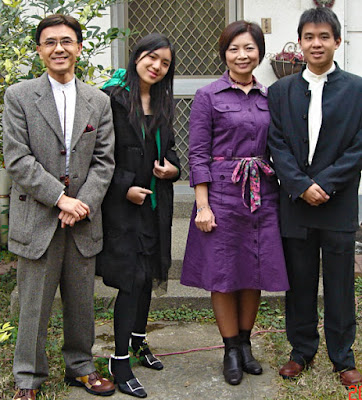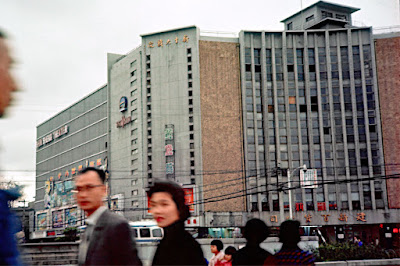In January 1970, the History of the 327th Air Division was published at Taipei Air Station. The document contained a FORWARD page. We begin today, the History of the United States Air Force in Taiwan.
.
Here are the words from that page:
.
The chronology of the 327th Air Division and its predecessor, the Air Task Force Thirteen (Provisional), is important in many respects. It provides a record of a unique experiment in the establishment of a task force of the United States Air Force which would cooperate and work with the Air Force of a friendly nation within the territory of that nation, and, if the need arose, take over the command of certain segments of that Air Force.
.
Although the tenseness of the political situation and the immediacy of the threat of war by the Chinese Communists, which led to the signing of a Mutual Defense Treaty between the governments of the United States and the Republic of China, had eased somewhat by the time Air Task Force Thirteen, Provisional, was activated, it was recognized by the governments concerned that a constant state of combat preparedness was necessary. This was demonstrated when the crisis of 1958 caused the activation of portions of the defense plan for Taiwan.
.
Over the years the air division has carried out its tasks as evidenced by the performance of the Chinese Air Force and its government. The division mission remained unchanged even though it changed from a provisional task force to the 327th Air Division until 1968 when it assumed the additional responsibility of providing airlift for Southeast Asia with the assignment of the 314th Tactical Airlift Wing. Today, in addition to its airlift role, the division stands ready, as it has for the past, to provide for Taiwan's defense.
.
As we look back on the history of the 327th Air Division, all of those who have been fortunate enough to play a part in keeping the aggressor from Taiwan can be justifiably proud of their efforts.
.
.
DEWITT R. SEARLES, Brig Gen, USAF Commander
.
Our next post will begin with the History of our Air Force in Taiwan, a very interesting and informative series of insight.
Taipei Air Station - 1966 - - - " What you have in the end are memories"......... Photo Courtesy of Richard Reesh.
Sunday, March 29, 2009
Saturday, March 21, 2009
MAAG Hsinchu Housing - The Next Residents

Interesting things begin to occur during the 1970s at the U.S.Military Hsinchu Housing Compound.
As the American military families vacated the western style homes, university faculty and students became the new residents.
Lets see what's happened at the Hsinchu Housing Compound HERE.
Sunday, March 15, 2009
Kamikaze Aircraft in Formosa
 Pictured here, a Kawasaki 48 Type 99 "Lilly" used as a "Kamikaze" aircraft by the Japanese. Here is a link.
Pictured here, a Kawasaki 48 Type 99 "Lilly" used as a "Kamikaze" aircraft by the Japanese. Here is a link.In a related subject recently discussed on one of our Hsinchu Posts we talked about a fuel factory just outside the MAAG Hsinchu Housing Compound. I wanted to find additional information on this factory, such as, what type of fuel was manufactured and what the fuel was used for. We believe the plant was operated by the Imperial Japanese Navy, manufacturing aircraft fuel. We know that Hsinchu Air Base was quite close to this area.
I emailed my friend Jim in Japan and asked if he could search for information on the Hsinchu Fuel Factory using the Japanese Language Internet sites and possibly find more information for me.
His search was not fruitful, nothing could be found in Japanese. In his return mail to me, he recalled an incident in his youth that was quite interesting. I have taken the liberty to tell his story as I understand his writing in English.
" I met a Kamikaze pilot about 6 months before the war ended. (Japanese surrendered in August 1945.)
I was 12 years old living in Japan. I met this pilot at a barbershop. He asked me if I had any letter paper and an envelope. He was staying at a hotel not far from my home.
I purchased the stationary and went to his hotel. He took me upstairs and I saw 6 or 8 pilots. I still remember his name, Master Sergeant Nishiko. He gave me some candy. During this period, things were in short supply, especially sweets.
He told me that his family lived on the outskirts of Nagoya. He said, "tomorrow we are heading to Okinawa, I'll be number 3 plane. The next morning about 0630 hours, 8 planes flew over our town. As I remember they were 99 Attacker aircraft, old type with fixed landing gear.(photo above)
After the war ended I tried many times to find his family but was never able to make contact."
My friend Jim who related this story to me spent many years in Taiwan after the war and is now retired in Japan at the age of 74.
Saturday, March 7, 2009
MAAG Hsinchu - Events In The Late 1950's

The couple passing before our camera lens were probably on their way to watch a film in the Hsen Sheng Theater in Taipei, circa 1959, an event in their lives.
Today, we move back to the late 1950s to remember a few events which took place in Hsinchu, events that touched the lives of MAAG Hsinchu families.
Our post starts HERE.
Sunday, March 1, 2009
MAAG Hsinchu - Commerce and Production 1950's
 Commerce for the most part, operates with money.
Commerce for the most part, operates with money. Here is a NT $1.00 note.
In 1959 this note would probably purchase a few things on it's own.
At the exchange rate of US $1.00 equals NT $40.00, this note was worth approximately US $.02 1/2 cents.
The China Post English language newspaper cost NT $1.20, about US $.03 cents in 1959.
It's time to look back at MAAG Hsinchu and some Commerce and Production activities of the hard working citizens of Taiwan in the late 1950's. The discussion starts here.
Subscribe to:
Posts (Atom)